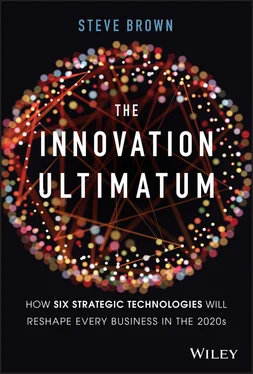Law enforcement uses AI to predict crime. PredPol is a collaboration between the Los Angeles Police Department (LAPD) and the University of California at Los Angeles (UCLA). PredPol predicts where and when serious crimes are most likely to happen. PredPol scientists claim the system has double the accuracy of human analysts. Importantly, the system only predicts the locations of future crimes, not the identities of people predicted to commit those crimes. We are still a long way from the precrime concept described in Philip K. Dick's Minority Report.
Most businesses need to make forecasts or predictions, and AI is just starting to scratch the surface in this space. AIs will power all manner of business planning systems: demand forecasts, risk analysis, design trends, and more.
Seeing the World through a New Lens with Super Sensors
Sensors, turbocharged by AI to create “super sensors,” will lift the veil from the world, extend our existing five senses, and allow us to perceive the world more fully. Like the microscope before it, AI gives us a new lens to view the world through; a lens to experience the world in all its complexity and beauty. Super sensors will oversee business operations, monitor the operation of equipment, create new products, and provide us a more holistic view of people.
An exciting early example of super-sensing capabilities comes from the work of Dr. Dina Katabi, a professor and research lead at MIT's Computer Science and Artificial Intelligence Lab (CSAIL). Katabi's team has created a super sensor. What adds to the delight of this particular story is that it begins with Star Wars and ends with Star Trek.
As a child, Katabi was fascinated by the notion of “The Force” in the Star Wars movies. Her fascination persisted into adulthood. In Star Wars , Obi Wan Kenobi describes a mystical force that “surrounds us, penetrates us, and binds the galaxy together.” As she considered the fictional notion of The Force, Katabi realized that a real force surrounds us all—electromagnetic energy. If you flap your arms up and down, you literally create a disturbance in that force. Katabi wondered if sensing electromagnetic energy would let her see the world in a new way.
Katabi's research team built a simple wall-mounted sensor and fitted it inside a room. The sensor emits and receives radio frequency (RF) signals, much like a Wi-Fi hotspot. RF signals tend to pass through walls but bounce back from people. The sensor picks up reflected RF signals and feeds data into a neural network that makes sense of the reflected signal data.
To train the AI, Dr. Katabi's team captured video of people moving around inside the room. The AI was fed the video and RF sensor data as parallel inputs. The AI found complex associations between the RF sensor data and the video images and eventually correlated the two. With this insight, the AI can determine what is happening inside the room from just the RF sensor data and can register when a person is standing, sitting, or lying down. Since RF signals pass through most walls, the AI can “see” through them and also “see” in the dark. Amazing. Katabi plans to use the sensor to monitor elderly patients under care. The sensor instantly detects when patients suffer a fall and calls for help. Incredibly, the sensor also detects vital signs—a patient's breathing and heart rate—and their sleep state—awake, light sleep, deep sleep, and REM sleep. If you understand how well a person sleeps, you can tell a lot about their health. Disturbances in deep sleep can indicate depression or anxiety. Disturbances to REM sleep can indicate early-onset Alzheimer's. Alzheimer's is also indicated by repetitive patterns of movement or motion, which the sensor also detects. Changes in a person's gait can indicate the development of Parkinson's disease.
By applying AI to a low-cost, wall-mounted RF sensor, we can monitor vital signs, sleep states, falls, and provide clinical insight on the development of conditions that include Alzheimer's, COPD, Parkinson's, and depression. All without a single wire being attached to the patient. The system operates without using a camera, limiting privacy concerns. Patients are monitored with their full consent, comfortable in the knowledge that no video images are ever being gathered. The sensor enables clinicians to “see” a wealth of information, all gathered wirelessly. We started this story with Star Wars and ended up with the sick bay beds from Star Trek.
Super-sensing turbocharges simple sensors with AI to reveal more about our world. Google's “Project Soli” technology uses short-range radar signals and machine learning to detect fine-grain finger gestures. This approach will transform sliders, buttons, and twistable crowns on mobile and wearable devices into virtual controls. More super sensors are detailed in Chapter 10on the future of healthcare. What other super sensors will we create? What super sensors will your business create?
Solving Complex Problems by Learning from Experience
Some challenges—optimizing a system with many variables or programming a robot to walk on two legs—are too difficult, too complicated, or too laborious to tackle with traditional computers. AI solves some of these tricky problems using a technique called reinforcement learning.
Reinforcement learning is a branch of machine learning that uses a system of digital rewards and punishments as part of its training process. Reinforcement learning systems solve previously intractable problems through an iterative process of experimentation. The AI tries a range of strategies and learns the best way to approach a problem through an intelligent form of trial and error. It's like harnessing digital evolution.
Reinforcement learning teaches computers to perform complex optimizations, control complex equipment, and to play games really, really well. In 2018, researchers trained an AI to play the classic Sega console game, Sonic the Hedgehog. Sonic has two simple controls: run and jump. An AI was trained with the video game display as input and the game controls as the output. In reinforcement learning, AIs have an additional input known as a reward function. As the AI trains it tries to optimize the reward function. Game points increase the reward, and the reward decreases substantially if Sonic loses a life. At first, the AI plays terribly. Over time, the AI optimizes its model to run and jump at just the right moment, score maximum points, and keep the adorable blue hedgehog alive. The AI does not learn based on simple timing; it learns from what is happening on the screen, so it can succeed on game levels it has not seen before.
The most regularly cited example of reinforcement learning is DeepMind's AlphaGo system. DeepMind, a subsidiary of Alphabet, built AlphaGo to play the ancient Chinese game of Go. Winning strategies for Go are opaque; even grand masters can't always describe why they choose some of the moves they make—they say the move just “feels right.” There are more possible configurations for pieces on a Go game board than there are atoms in the universe. To build a machine that understands the nuances and subtle strategies of this complex game is a monumental challenge.
AlphaGo was not taught game strategies. It developed its own strategies through observation of many human versus human games. In March 2016, AlphaGo played 18-times world champion Lee Sedol, the best (human) Go player in the world. AlphaGo beat the legendary player, four games to one. To win, AlphaGo deployed several new strategies that went against hundreds of years of received wisdom among expert players. By observing AlphaGo's approach, human players have improved their play. This story offers an important lesson. Rather than consider AI a threat to our unique humanity and our value within the workplace, we might instead think of AI as a sophisticated partner, one that boosts our skills and that ultimately elevates our humanity.
Читать дальше












